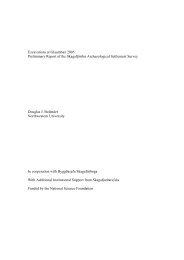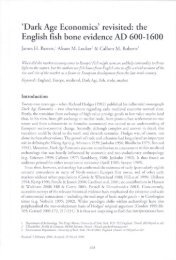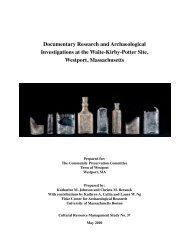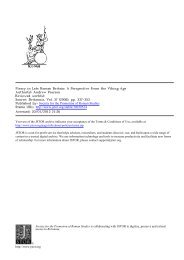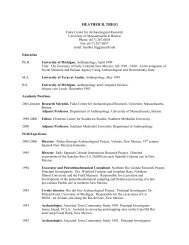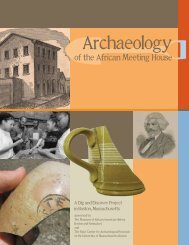archaeological site examination north yard of the ... - Fiske Center
archaeological site examination north yard of the ... - Fiske Center
archaeological site examination north yard of the ... - Fiske Center
Create successful ePaper yourself
Turn your PDF publications into a flip-book with our unique Google optimized e-Paper software.
Figure III-3: The Loring-Greenough property as depicted by Hopkins Insurance Co. in<br />
1874 (Detwiller 1998).<br />
E. Archaeological Potential <strong>of</strong> <strong>the</strong><br />
Loring-Greenough House Property<br />
Native resources in this area may retain<br />
research significance.<br />
The Loring-Greenough property is listed on<br />
<strong>the</strong> National and State registers <strong>of</strong> Historic<br />
Places and has been nominated for local<br />
landmark status. The property consists <strong>of</strong><br />
nearly two acres in <strong>the</strong> historic center <strong>of</strong><br />
Jamaica Plain, adjacent to two National<br />
Register Historic Neighborhoods and close<br />
to <strong>the</strong> Arnold Arboretum and Jamaica Pond,<br />
part <strong>of</strong> Boston’s Emerald Necklace.<br />
No evidence <strong>of</strong> Native American occupation<br />
<strong>of</strong> <strong>the</strong> property was found prior to <strong>the</strong><br />
North Lawn investigation. The <strong>site</strong>’s location<br />
on well-drained upland not far from<br />
streams and wetlands, however, suggested<br />
<strong>the</strong> potential for such presence. Nine<br />
Native <strong>site</strong>s spanning in time between 8000<br />
and 400 B.P. have been identified in <strong>the</strong><br />
Arnold Arboretum only 500 m southwest <strong>of</strong><br />
<strong>the</strong> property. Additionally, extensive wetlands<br />
associated with Muddy River (area <strong>of</strong><br />
Jamaica Pond) lie approximately 600 m to<br />
<strong>the</strong> <strong>north</strong>west. Even partially disturbed<br />
The Loring-Greenough property clearly<br />
possesses high potential for historic <strong>archaeological</strong><br />
resources. The <strong>yard</strong> surrounding<br />
<strong>the</strong> house is likely to contain remains that<br />
could increase our understanding <strong>of</strong> 1) a<br />
seventeenth to early eighteenth century<br />
farmstead (Polley Farm), 2) an eighteenthcentury<br />
country estate (Loring family), 3)<br />
Revolutionary War hospitals, commissaries,<br />
bakeries, and arsenals, and 4) late eighteenth<br />
and nineteenth-century domestic life<br />
and farming practices (Greenough family).<br />
In addition to its extant structures, <strong>the</strong> parcel<br />
may retain evidence <strong>of</strong> <strong>the</strong> 1807 coach<br />
house, (on <strong>the</strong> <strong>site</strong> <strong>of</strong> <strong>the</strong> present tennis<br />
court), <strong>the</strong> 1807 mill house, <strong>the</strong> 1796 barn,<br />
and o<strong>the</strong>r early out buildings. Given <strong>the</strong><br />
documented presence <strong>of</strong> eighteenth century<br />
gardens, <strong>the</strong> property may also retain data<br />
important to early gardening practices and<br />
design.<br />
14



